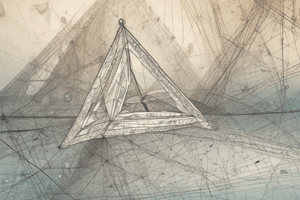Podcast
Questions and Answers
What is the primary goal of algebra?
What is the primary goal of algebra?
- To represent relationships between quantities using symbols and variables (correct)
- To calculate areas and volumes of geometric shapes
- To prove theorems in Euclidean geometry
- To analyze statistical data
Which type of equations have graphs that are straight lines?
Which type of equations have graphs that are straight lines?
- Linear equations (correct)
- Exponential equations
- Cubic equations
- Quadratic equations
What do variables and constants represent in algebra?
What do variables and constants represent in algebra?
- Variables represent constants, and constants represent variables
- Variables represent known quantities, and constants represent unknown quantities
- Variables represent unknown quantities, and constants represent known quantities (correct)
- Variables represent relationships, and constants represent operations
Which mathematical concept involves determining the value(s) of a variable that make an equation true?
Which mathematical concept involves determining the value(s) of a variable that make an equation true?
Which type of equations have graphs that are parabolas?
Which type of equations have graphs that are parabolas?
What do systems of equations involve in algebra?
What do systems of equations involve in algebra?
What are some key concepts in geometry?
What are some key concepts in geometry?
How are algebra and geometry applied in engineering and architecture?
How are algebra and geometry applied in engineering and architecture?
Which branch of mathematics is essential for calculating the volume of three-dimensional shapes?
Which branch of mathematics is essential for calculating the volume of three-dimensional shapes?
How do algebra and geometry contribute to solving real-world problems?
How do algebra and geometry contribute to solving real-world problems?
What mathematical concept helps us understand the turning between rays or segments sharing a common endpoint?
What mathematical concept helps us understand the turning between rays or segments sharing a common endpoint?
In what way do coordinate systems assist in geometry?
In what way do coordinate systems assist in geometry?
Flashcards are hidden until you start studying
Study Notes
Math: Exploring Algebra and Geometry
Math is a diverse and profound field encompassing various areas of study, including algebra and geometry. In this article, we'll take a closer look at these subdisciplines and their interconnectedness, uncovering the foundational concepts and their real-world applications.
Algebra
Algebra is the branch of mathematics where we work with symbols and variables to represent relationships between quantities, often involving equations. The primary goal of algebra is to solve equations and systems of equations, develop patterns and formulas, and analyze relationships between variables.
Some key concepts in algebra include:
- Variables and constants: Representing unknown quantities with variables (e.g., x, y, z) and known quantities with constants (e.g., 3, 7, π).
- Equations: Statements that provide an equality between two expressions.
- Expressions: Combining variables and constants using arithmetic operations (e.g., addition, subtraction, multiplication, division).
- Solving equations: Determining the value(s) of the variable that make the equation true.
- Linear equations: Equations whose graphs are straight lines (e.g., y = mx + b).
- Quadratic equations: Equations whose graphs are parabolas (e.g., y = x^2).
- Systems of equations: Two or more equations that must be solved simultaneously.
Geometry
Geometry is the branch of mathematics where we study shapes, measure their properties, and explore spatial relationships. Geometry is a visual field that helps us understand and describe the world around us, as well as develop spatial reasoning and problem-solving skills.
Some key concepts in geometry include:
- Points, lines, and planes: Fundamental concepts in two-dimensional and three-dimensional geometry.
- Coordinate systems: Associating points with ordered pairs or triplets of numbers to locate them on a plane or in space.
- Distance and midpoint: Calculating the distance between two points and finding their midpoint.
- Angles: Measuring the turning between two rays or segments that share a common endpoint.
- Triangles: A three-sided polygon with various properties (e.g., interior and exterior angles, the sum of angles, and the Pythagorean theorem).
- Circles: A set of points equidistant from a fixed point (the center).
- Area and perimeter: Measuring the size of two-dimensional shapes.
- Volume and surface area: Measuring the size of three-dimensional shapes.
Application of Algebra and Geometry
Both algebra and geometry are essential for understanding and applying various concepts in mathematics, science, and engineering. For instance:
- Solving problems: Algebra and geometry help us solve real-world problems, such as finding the area of a field or the volume of a box.
- Graphing: We use algebra to represent relationships as graphs and use geometry to analyze and interpret the graphical representation.
- Engineering and architecture: Algebra and geometry help engineers and architects design buildings, bridges, and other structures.
- Biology and chemistry: Algebra and geometry are used to analyze and model biological and chemical processes.
- Physics: Algebra and geometry help us understand and model physical phenomena, such as motion and force.
In conclusion, algebra and geometry are fundamental branches of mathematics that provide a strong foundation for understanding and solving problems in various fields. By mastering these concepts, we can develop critical thinking skills, spatial reasoning, and problem-solving abilities, opening up numerous opportunities for success in our personal and professional lives.
Studying That Suits You
Use AI to generate personalized quizzes and flashcards to suit your learning preferences.




